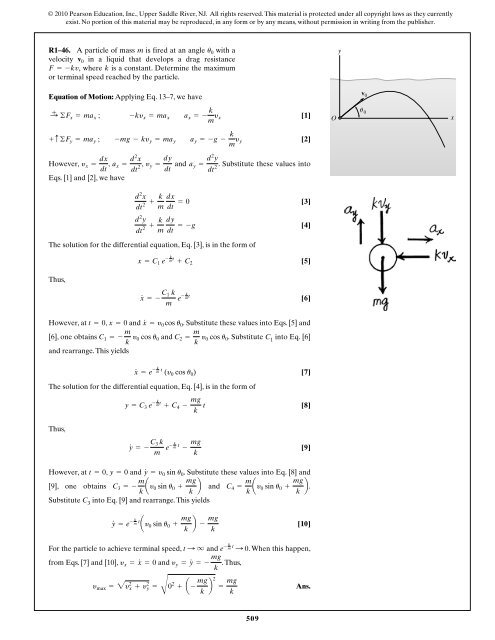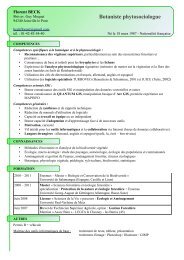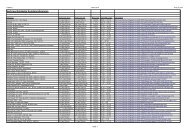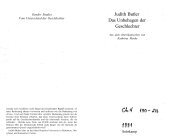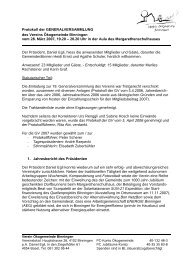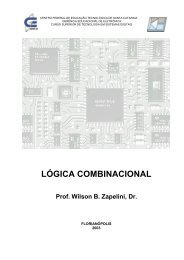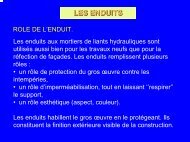479 Horizontal Motion: The horizontal component of velocity ... - Wuala
479 Horizontal Motion: The horizontal component of velocity ... - Wuala
479 Horizontal Motion: The horizontal component of velocity ... - Wuala
You also want an ePaper? Increase the reach of your titles
YUMPU automatically turns print PDFs into web optimized ePapers that Google loves.
91962_05_R1_p0<strong>479</strong>-0512 6/5/09 3:56 PM Page 509<br />
© 2010 Pearson Education, Inc., Upper Saddle River, NJ. All rights reserved. This material is protected under all copyright laws as they currently<br />
exist. No portion <strong>of</strong> this material may be reproduced, in any form or by any means, without permission in writing from the publisher.<br />
R1–46. A particle <strong>of</strong> mass m is fired at an angle u 0 with a<br />
<strong>velocity</strong> v 0 in a liquid that develops a drag resistance<br />
F = -kv, where k is a constant. Determine the maximum<br />
or terminal speed reached by the particle.<br />
y<br />
Equation <strong>of</strong> <strong>Motion</strong>: Applying Eq. 13–7, we have<br />
: + ©F x = ma x ; -ky x = ma x a x = - k m y x<br />
[1]<br />
O<br />
v 0<br />
0 u<br />
x<br />
+ c ©F y = ma y ; -mg - ky y = ma y a y = -g - k m y y<br />
[2]<br />
However, , , and a y = d2 y<br />
a y y = dy<br />
x = d2 x<br />
y x = dx<br />
. Substitute these values into<br />
dt dt 2 dt<br />
dt 2<br />
Eqs. [1] and [2], we have<br />
d 2 x<br />
[3]<br />
dt 2 + k dx<br />
m dt = 0<br />
d 2 y<br />
[4]<br />
dt 2 + k dy<br />
m dt = -g<br />
<strong>The</strong> solution for the differential equation, Eq. [3], is in the form <strong>of</strong><br />
Thus,<br />
x = C 1 e - k m t + C 2<br />
x # C 1 k<br />
= -<br />
k m<br />
e- m t<br />
[5]<br />
[6]<br />
However, at t = 0, x = 0 and x # = y 0 cos u 0 . Substitute these values into Eqs. [5] and<br />
m<br />
[6], one obtains C and C 2 = m 1 = -<br />
. Substitute C 1<br />
into Eq. [6]<br />
k y 0 cos u<br />
k y 0 cos u 0<br />
0<br />
and rearrange. This yields<br />
x # = e - k m t (y 0 cos u 0 )<br />
<strong>The</strong> solution for the differential equation, Eq. [4], is in the form <strong>of</strong><br />
y = C 3 e - k m t + C 4 - mg<br />
k t<br />
[7]<br />
[8]<br />
Thus,<br />
y # C 3 k<br />
= -<br />
k m<br />
e- m t - mg<br />
k<br />
[9]<br />
However, at t = 0, y = 0 and y # = y 0 sin u 0 . Substitute these values into Eq. [8] and<br />
[9], one obtains C m<br />
and C 4 = m .<br />
k ay 0 sin u 0 + mg<br />
3 = -<br />
k ay 0 sin u 0 + mg<br />
k b<br />
k b<br />
Substitute C 3<br />
into Eq. [9] and rearrange. This yields<br />
y # = e - k m t ay 0 sin u 0 + mg<br />
k b - mg<br />
k<br />
[10]<br />
For the particle to achieve terminal speed, t : q and e - k m t : 0. When this happen,<br />
from Eqs. [7] and [10], and y y = y # mg<br />
y x = x # = 0<br />
= - . Thus,<br />
k<br />
y max = 2y 2 x + y 2 y = 0 2 mg<br />
2<br />
+ a - C k b = mg<br />
k<br />
Ans.<br />
509


